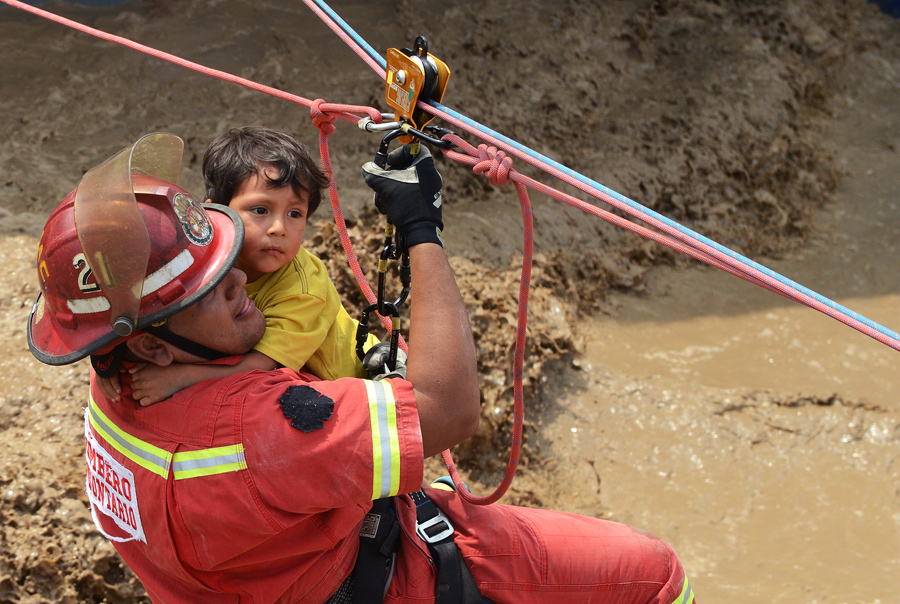Blog by: by Jacqueline Salguero Huaman

At the end of last year, I was discussing the main objective of FIN for 2019, namely building climate resilience, with Jacqueline Salguero Huaman, from Peru.
“Community engagement is everything” she said, “This kind of stuff is going to keep happening, and which government has enough money to pay for damages each time! I know this for sure from our Peruvian experience”.
“This is a bit scary Jacqueline, but I totally agree and that’s why we need to teach people more about it. Could you please tell us about what happens in Peru? We’ll learn from it for sure.” And this is what she wrote for us:
What is the repeated ecological problem in Peru and why do you think solutions have not been found?
According to historical evidence from Pre-Inca and Inca cultures, heavy rain on the coast and droughts in the highlands took place on a regular basis. Indigenous priests oversaw the administration of nature and developed clear mandates on where to construct buildings and storage facilities (“colcas,” in Quechua) to prepare for periods of drought and heavy rain. During the Spanish conquest, these abrupt changes in weather conditions were described as punishment from the Gods resulting in a higher effort to convert the indigenous population into Catholicism.

It is not until the end of the XIX century, that the meteorological phenomenon that affects, primarily two countries Peru and Ecuador received its name “El Niño” (the boy in English). The name was given by fishermen in the North of Peru referring to Jesus Christ because it starts after the Christmas season. It usually takes place in 2 to 5 years intervals at different intensities. El Niño is caused by the alteration of the trade winds, from west to east, which pushes unusually warm waters through the eastern tropical Pacific all the way to the coast of South America. This process alters the entire temperature of the Pacific Ocean causing extreme rainfall, and which leads to flash flooding accompanied by mudslides (“huaycos” in Quechua) in the Coast and cold waves in the highland. It cannot be controlled because this will require cooling down the entire Pacific Ocean. Therefore, the only solution is to build resilience and develop prevention mechanisms.

A bus is seen after a landslide and flood in Chosica, east of Lima, Peru March 16, 2017. REUTERS/Guadalupe Pardo – RTX31CYS
Even though it is a well-known phenomenon, Peru is always negatively impacted. The country has suffered significant damage through the loss of human lives, the displacement of thousands of people, destruction of crops and infrastructure (houses, schools, main roads, and rural roads).
Let me explain why long-term solutions to mitigate the potential impacts have not been found. Firstly, as the population is growing and migration from rural areas to urban areas takes place, there has been a disorganized construction of houses and infrastructure in areas of high risk, like in areas close to rivers and ravines. The authorities did not approve and controlled the construction in these areas. Therefore, when floods hit these vulnerable areas, the weak infrastructure collapses, and villages are left disconnected from the outside world. Following such incidents, the reconstruction plans are implemented very slowly.

View of sections of the central railroad track that follows the Rimac River, which suffered severe damage by rising water and flash foods in the town of Chosica, at the foot of the Andes mountains east of Lima, on March 18, 2017.
Second, a national monitoring a system throughout the year is in place, and some infrastructure has been constructed such as dynamic protection barriers. However, during the El Nino phenomenon of 2017 this infrastructure collapsed as it was not resistant enough. Moreover, available information is often not disseminated on time, and thus evacuation plans are only put in place when the authorities have declared a red alert, which is too late for most people. For example, people are just evacuated when flooding is taking place and not before.
Third, to mitigate the impacts, only since 2011, after a devastating earthquake, did the country put in place an institution to identify and manage risks. However, this institution does not have a national budget and acts as an advisor in charge of providing training and suggest new projects to provinces at risk. As a result, the implementation role relies on the willingness and criteria of local authorities. Evidence shows that local authorities do not always have the adequate skills to manage their budgets and thus tend to prioritize short-term solutions over long-term ones. Also, when elections take place, new authorities do not always follow previous plans.

The El Nino climate phenomenon is causing muddy rivers to overflow along the entire Peruvian coast, isolating communities and neighbourhoods. Thousands have been affected since January, and 72 people have died. Most cities face water shortages as water lines have been compromised by mud and debris. / AFP PHOTO / CRIS BOURONCLE (Photo credit should read CRIS BOURONCLE/AFP/Getty Images)
Fourth, Peru applies a bottom-up approach to mitigate natural disasters. In other words, each province is assigned a small budget to reduce these risks. When the province faces a natural disaster, the issue escalates to the regional level and then subsequently to the national level. Therefore, the state of emergency is declared after the problem has scaled up and cannot be controlled by provinces authorities.
Fifth, municipalities and provinces oversee alerting their people about the coming and situation of the raining season. However, in the recent El Niño, many villagers were not informed on time about safety areas and the expected weather conditions.
As we stated at the beginning, Peru is not the only country that has been impacted by El Niño. Ecuador has also suffered from it, however; the country planning and prevention approach is slightly different and has resulted in much fewer losses. Ecuador has implemented six mega water and infrastructure projects that include flood control and water storage, as well as strategic decanting systems to transfer water to agricultural areas. These projects constituted a total investment of about US$ 1,000 million from 2014 to 2016. Moreover, the country uses orange alerts before red alerts to implement their evacuation plans that include early warning brigaded and evacuation drills.

Source: National Newspapers
In sum, to face up this phenomenon the state’s capacity to prevent and mitigate the impact should be strengthened. It will be necessary to declare areas close to rivers and ravines as uninhabitable and create awareness of the necessity to live in resilient areas. Moreover, investment in infrastructure (e.g., water reservoirs and water canals) and in mega projects like in Ecuador could help mitigate the impacts on critical infrastructure such as houses, schools, and bridges.

A man stands inside his house after a landslide and flood in Chosica, east of Lima, Peru March 16, 2017. REUTERS/Guadalupe Pardo – RTX31CXX
The institution in charge of the system of risk should be able to control part of the budget so that they can address and prioritize the projects that they consider relevant. In this way, provincial authorities and newly elected authorities will be following one plan. Also, this institution could extend their direct beneficiaries’ group by providing practical advice such as artificial respiration techniques in schools. Currently, most courses focus on what should be done in the event of tremor and earthquake.
Furthermore, as in the case of Ecuador, the central government should oversee informing and form early warning brigade in collaboration with the local authorities to share responsibilities. This should include smart waste management systems that are currently not in place causing cholera, typhoid, and other diseases during the flood period.

Residents of the Huachipa populous district, east of Lima, are helped on March 17, 2017, by police and firemen rescue teams to cross over flash floods hitting their neighbourhood and isolating its residents.
The climatic phenomenon El Niño is causing muddy rivers overflows on the entire Peruvian coast, isolating hundreds of people, mostly residents of Limas industrial belt neighbourhoods. / AFP PHOTO / CRIS BOURONCLE (Photo credit should read CRIS BOURONCLE/AFP/Getty Images)


